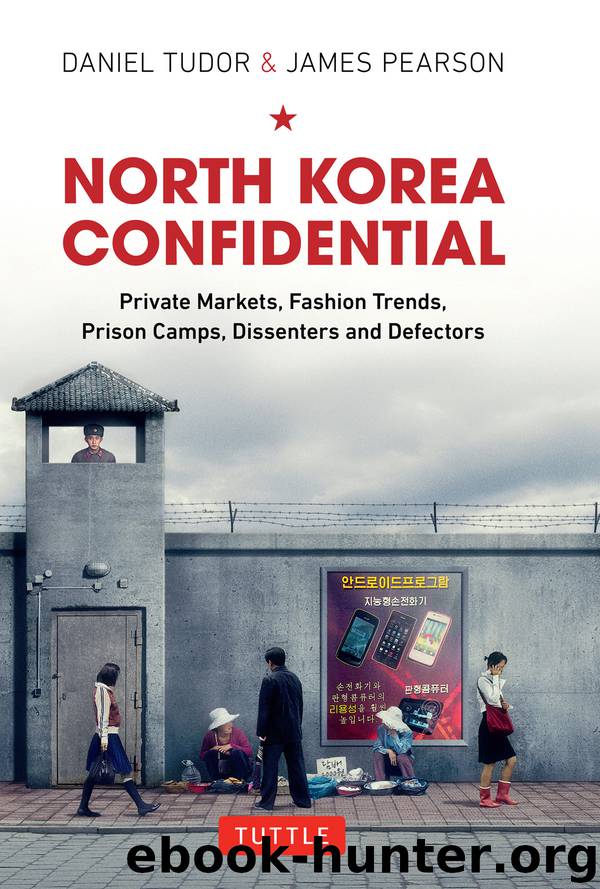North Korea Confidential : Private Markets, Fashion Trends, Prison Camps, Dissenters and Defectors (9781462915125) by Daniel Tudor & James Pearson

Author:Daniel Tudor & James Pearson [Tudor, Daniel & Pearson, James]
Language: eng
Format: epub
ISBN: 9780804844581
Published: 0101-01-01T00:00:00+00:00
The Organization and Guidance Department
Kim Jong Un has inherited a system in which he is utterly necessary, owing to the family personality cult. But he has also inherited a system in which genuine loyalty has been mostly replaced by fear, and where a “court economy” and payoffs encourage infighting and rent-seeking. And most importantly (for him, at least), he has inherited a system in which one rather shadowy organization may possess more power than he does, despite being leader of the country, and head of the ruling Workers’ Party.
That organization is the OGD, and it represents the summation and natural extension of what Kim Jong Il learned during the early stages of his rise to power, particularly the Three Revolutions period. Through surveillance and the re-routing of information and reporting structures, the OGD has come to be the only part of the state that sees and knows everything. Though many famous figures have been ousted following Kim Jong Il’s death—including General Ri Yong Ho and Jang Song Thaek—the OGD leadership is essentially unchanged.
The OGD has existed since 1946, but its role was reinvented following Kim Jong Il’s accession to its directorship in 1973, when he began to use it as the main means by which to take control of the state.10 The OGD since then has risen to become the central hub of power in North Korea. It possesses a file on “anyone who is anyone”; it is the conduit via which the various branches of government communicate with the Supreme Leader, passing instructions down and information up; it is responsible for implementing and enforcing policy; it runs a network of spies that reach from the highest army general to the lowest provincial factory manager; it “signs off” on any government or military appointment; and it is essentially in charge of the personal security and well-being of the ruling family.
So while one may consider a high-ranking army general or minister to be powerful—and indeed he would be, within his own organization and network11—ultimate power flows through the OGD; nobody else has full organizational visibility. Thus, while the outside world may have been watching bodies like the Politburo, such “traditional” Kim Il Sung-era organizations had lost much of their real power to the OGD. That may have been Kim Jong Il’s smartest trick of all: to shift the power base without outsiders realizing. It has been reported that he liked to say “we must envelop our environment in a dense fog, to prevent our enemies from learning anything about us.” And certainly, he knew well how to achieve that.
But how does the 300-man OGD “run” North Korea today? Let us now examine in more detail the powers it holds, starting with its control over personnel. To Illustrate by way of example, imagine you are a factory manager at the Chollima Steel Complex, one of the DPRK’s most important state-owned enterprises. A promotion comes up—the crucial role of party secretary for the factory. You may be asked if you are interested, or you may apply for the role on your own initiative.
Download
This site does not store any files on its server. We only index and link to content provided by other sites. Please contact the content providers to delete copyright contents if any and email us, we'll remove relevant links or contents immediately.
| Anthropology | Archaeology |
| Philosophy | Politics & Government |
| Social Sciences | Sociology |
| Women's Studies |
Cecilia; Or, Memoirs of an Heiress — Volume 1 by Fanny Burney(32067)
Cecilia; Or, Memoirs of an Heiress — Volume 3 by Fanny Burney(31463)
Cecilia; Or, Memoirs of an Heiress — Volume 2 by Fanny Burney(31412)
The Great Music City by Andrea Baker(30785)
We're Going to Need More Wine by Gabrielle Union(18640)
All the Missing Girls by Megan Miranda(14762)
Pimp by Iceberg Slim(13787)
Bombshells: Glamour Girls of a Lifetime by Sullivan Steve(13691)
Fifty Shades Freed by E L James(12923)
Talking to Strangers by Malcolm Gladwell(12887)
Norse Mythology by Gaiman Neil(12846)
For the Love of Europe by Rick Steves(11543)
Crazy Rich Asians by Kevin Kwan(8894)
Mindhunter: Inside the FBI's Elite Serial Crime Unit by John E. Douglas & Mark Olshaker(8708)
The Lost Art of Listening by Michael P. Nichols(7169)
Enlightenment Now: The Case for Reason, Science, Humanism, and Progress by Steven Pinker(6878)
The Four Agreements by Don Miguel Ruiz(6324)
Bad Blood by John Carreyrou(6283)
Weapons of Math Destruction by Cathy O'Neil(5841)
